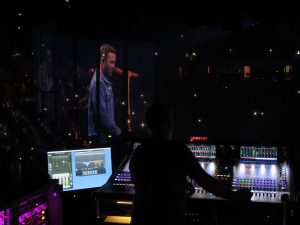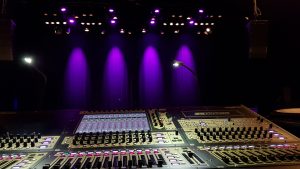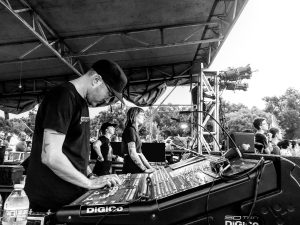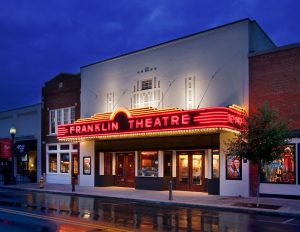DiGiCo Audio Consoles Power Global Musical, Theatrical Acts
Story Highlights
DiGiCo has been responsible for the audio production of musical and theatrical acts across the globe.
 On Point for Justin Timberlake
On Point for Justin Timberlake
Justin Timberlake has been a mainstay in the charts, and on our TV screens, for the best part of three decades. Timberlake is currently on his sixth world tour, Man Of The Woods. His two live sound engineers, Andy Meyer and Paul Klimson, both rely on DiGiCo consoles supplied by Clair Global, the touring sound reinforcement provider.
“The SD7 offers an input count, flexibility, and sonic clarity that is unsurpassed by other platforms,” says Meyer, whose DiGiCo SD7 console is receiving 200 input paths at FOH, with 138 outputs. “I’ve got snapshots for changes that I want to make, and I fire it all off of time code. I used to do it manually, and I have foot switches to do it, just in case.”
The snapshots are starting points, Meyer explains, as throughout the performance he’s making slight adjustments: “I don’t EQ the system, I let the system be the system, and I fix it in snapshots. If there’s a frequency bugging you, you find out what it is, and then you put a snapshot in to clean it up — you learn those things over time, so frequency-wise, I’m pretty set; it’s level-wise that I’m doing the work in real-time.”
Meyer likes to be hands-on with Timberlake’s vocal: “you can’t just leave that up,” he insists. “That’s because everyone is everywhere, so I have to make changes around that. Every once in a while, you have that magic show that’s perfect, and you just laugh and go through the motions, but it’s pretty much always an adjustment situation.”
Monitor engineer Paul Klimson has worked with Timberlake since the artist’s 20/20 tour in 2013. He says the SD7 was a no-brainer for this show. “The SD7 is the only console to use when you’re talking big channel counts,” he insists. “And it really does come down to that. Also, the surface layout, flexibility of programming with the macros, and having the ability to see many channels at once keeps all the important things under my fingers without having to page around to find things.”
The show file Klimson works off now has been in existence since 2014. It was a pretty full file back then, he says, but on this tour even more inputs and outputs have been added. “There are two stage racks and a Nano rack, and I use all of the inputs, so we’re at 140 channels,” he explains. “I’m really excited to change over to DiGiCo’s new Quantum engine when it becomes available, and explore the new options and features that will aid us monitor engineers.”
Klimson says this tour is a lot of fun: like driving a Ferrari, in fact! “In-ear mixing for bands is quite utilitarian, as they have to hear everything, so you give them a decent mix – especially this band, because they are all playing together and vibing off of each other. There are 32 stereo monitor mixes between Justin, the dancers, and the band; they have a couple of players that come and go. We are very lucky working with these guys!”
 Giving Norway’s Folk Scene Everything It Needs
Giving Norway’s Folk Scene Everything It Needs
In the autumn of 2010, Riksscenen, Norway’s national venue for folk and traditional music and dance, opened a new, purpose-built venue in Oslo’s trendy Grünerløkka and invested in two DiGiCo SD8s. This summer, it invested in an additional DiGiCo console, this time opting for an S31, which has been installed in the venue’s Klubbscenen (the club) for smaller gigs.
“The SD8s were chosen by my predecessor in the first instance because of their audio quality and I/O capacity, particularly when compared to other products in their price range,” recalls Magnus Opsahl Smaadahl, head of technical development at Riksscenen who, starting as one of the in-house engineers, had instantly fallen in love with the console’s sound quality and ability to be customised. “Initially, the two mixers were on two different stages — one in the main hall and one on the Club stage – the idea being to perform rehearsals and pre-productions for shows on the Club stage and copy the show files to the mixer in the main hall.
“After a while, it was apparent that we needed different setups from time to time, as well as a monitor mix, so we decided to have both mixers in the main hall. Because the SD8s are physically quite heavy, we wanted to move them as little as possible, so an analog console was used as the main mixer for the Club stage.”
With the analog console feeling its age and restricting what could be done at monitors in terms of capacity and effects, earlier this year the Riksscenen team decided the time was right to invest in another DiGiCo console. This time an S31 one was chosen supplied, as were the SD8s, by DiGiCo’s Norwegian distributor Scandec Systemer. The console was installed without any change to the venue’s original system, with Magnus integrating the S31 himself and Scandec assisting him with the installation of a DMI card; a simple plug and play with the existing coaxial and XLR patch.
“We wanted a console that’s portable, as we sometimes use it for our smaller stage or ad-hoc settings around the venue,” says Opsahl Smaadahl. “We also wanted built-in I/O — with the DMI option we can also hook up our existing DiGi-Rack for extra I/O — and MADI options, all an economic price point. The S31 seemed perfect, being lower in cost than the SD Range consoles, but still giving us the I/O and processing we need.”
Riksscenen has found that the S31 has brought many advantages with it, including fast setup and reliable multitrack via a MADI equipped sound card, making it easy for them to say ‘yes’ when artists ask for their set to be recorded.
“In folk music, you work with a lot of special instruments, so the multiband compressor is a great tools for this genre,” says Opsahl Smaadahl. “And the shared Rack for the monitor mix is great for our small venue; it makes it easy for me to prepare the system before our in-house technicians starts rehearsal with the band.”
The S31 experience has been nothing but good for Riksscenen.
“Håvard Hanserudfrom Scandec gave me a run through and the training videos that DiGiCo has produced have been a great help for our in-house engineers,” Opsahl Smaadahl concludes. “I am very happy with the performance of the S31, as are our in-house engineers. It has really given our club stage the tools we need to keep up with the increasing demand for I/O and audio control.”
 Eliminating Worries on St. Vincent’s Fear The Future Tour
Eliminating Worries on St. Vincent’s Fear The Future Tour
After a stint as a “solo theatrical show” on tour, St. Vincent roared back this year for a tour with a full band. This summer legs of the Fear The Future tour, in support of 2017’s Masseduction LP, saw St. Vincent (née Annie Clark) headlining the festival circuit, with stops at All Points East and End Of The Road, among other fests.
In tow were a pair of DiGiCo SD10 consoles for front of house and monitors, supplied by VER/PRG and operated by FOH Engineer Adam Jackson and Monitor Engineer Alex MacLeod. The desks were connected through an Optocore network, which also comprised a full DiGiCo SD-Rack at monitors, an SD-Mini Rack at FOH, and an Orange Box converter.
“The SD10s give us the workflow we need for this kind of show,” says MacLeod, who came on board the tour in March, as St. Vincent transitioned from solo shows using tracks to performances with the full band. “In the Optocore loop, we were able to share head amps and share control of the gain. We used the same network to communicate using the text-chat feature on the DiGiCo desks, as well as having a talkback for each member of the band. Everything was well connected on this tour.”
It had to be: MacLeod says that as creatively talented as Clark is, she is equally technically adroit. “Some artists sort of know what they want when it comes to the live sound and kind of how to get it; Annie knows exactly what she wants and she knows how to make it happen,” he says. “She really knows audio, and she won’t hesitate to call you out if it’s not right.”
Thus, Clark’s voice and guitars were the most active parts of the snapshot recalls for each song, he explains, with the three piece band behind her — each on their own 8×8-foot riser onstage — kept at a consistent level throughout the show. MacLeod says he’s been using SD consoles since 2008 on a variety of touring artists, and knowing where everything is — because the SD’s flexible routing and layout let him put everything exactly where he wants it — allows him to concentrate on the mix and not the console management.
Before the show, he uses the SD10’s wireless remote app on an Apple iPad to go on stage and listen from each musician’s perspective, and to generate pink noise for system tuning (he’s doing his own system tech work on this tour). St. Vincent’s performances are intense, and he says he has to remain constantly engaged throughout the show. An Optocore networked talkback between everyone helps, as does the somewhat restricted movement onstage due to the risers; finally, MacLeod has an infrared camera trained on Clark so he can see her movements even when the light show is at its peaks. (In fact, early on in the tour he worked with the production manager to move the monitor position to stage right from stage left so he could see her more clearly.) “That’s why the SD10 is so important,” he says. “You have to stay on top of this show every minute, and the SD10 has the features that let me do just that.”
Jackson’s tenure with St. Vincent extends back to the earlier solo portion of the tour, which also utilized a pair of SD10 consoles, and where the use of the Orange Box originated. The solo Clark was sonically cosseted with 32 channels of 96kHz backing tracks that played from MOTU’s Digital Performer software on a MacBook Pro through the Orange Box as MADI stems, a role it continues to play with the band.
“I first got the idea to use it like that when I was working with Sia and Demi Lovato on tour,” he explains. “With Sia, we had as many as 56 tracks coming out of the Box right onto the Optocore loop through an Optocore card in the Orange Box and then to the console. Combined with the flexibility of the SD worksurface, you can make even pretty complex workflows very manageable.”
Jackson agrees with his colleague, MacLeod, that a St. Vincent gig can be an intense one at the console. But that intensity is mitigated by the SD10’s automation and flexibility. “Of all the things I like about the console — and I’ve been using an SD10 for five or six years now — it’s having that screen in the center that’s the best,” he says. “I never have to look this way or that over the console — everything I need is all right there in front of me. It really helps keep the focus on the show. And you don’t need any tricks to get the SD10 to sound the way you want it to. We use a Shure KSM8 on Annie’s vocals with just some Empirical Labs Distressor set at 4:1 with fast attack and release, the Empirical Labs Lil Freq, and a Bricasti vocal reverb. Everything else I need is onboard the SD10, so it’s a very simple, reliable and great-sounding signal chain.”
And like MacLeod, Jackson has witnessed Clark’s sharp ear in action. “On the few occasions we’ve had to hop onto to another console for a show, she’ll let you know that she knows we’re not on the DiGiCo,” he says. “It makes that much of a difference.”
 Bringing 21st Century Sound in Classic Franklin Theatre
Bringing 21st Century Sound in Classic Franklin Theatre
The Franklin Theatre first opened as a cinema in the summer of 1937, when moviegoers could see a double feature and cap the evening with an ice cream sundae on a Norman Rockwell-esque Main Street. Seventy years later, the theater underwent an $8 million renovation and reopened in 2011 as the premier music and event venue in Franklin, a suburb of Nashville that is home to nearly as many musicians as Music City itself is.
Seven years later, the cherry just landed on top of that ice cream sundae in the form of a DiGiCo SD12 digital console at front of house. Paired with a D2-Rack, the desk was supplied and installed in mid-August by Dan Heins of Clair Solutions, completing the Franklin Theatre’s renaissance as the entertainment center of the city, drawing headline artists from Nashville, nationally and globally.
“Although our previous digital console has served us well since the theatre reopened, it had definitely reached a timely retirement age,” says Richard Korby, the venue’s technical director and head of audio for the last two years, following two-plus decades of touring, most recently with Major League Baseball, Straight No Chaser, Jake Owen, and others. “We looked at a lot of possibilities for a new FOH console but nothing even came close to what the SD12 offered. We’re a non-profit, so bang for the buck means everything, and the SD12 won that debate easily.”
Franklin Theatre Executive Director Dan Hayes asked Korby to use his instincts to decide on the new FOH desk. “It wasn’t a hard choice to make,” he says. “DiGiCo is what we see on all the riders that come through here. It’s what everyone wants to use.”
Korby cites the SD12’s customizable work surface and highly flexible workflow possibilities as a main attraction. “We’re building work-surface templates for our engineers and visiting users, and we can make it look like a classic analog console for those who prefer that, or a multi-layer digital desk for mixers who like that model,” he says, citing DiGiCo’s floating-point Super FPGA technology. “It can be anything you want it to be.”
The Franklin Theatre boasts an elite team of independent audio engineers, including Kyle Miller (Nitty Gritty Dirt Band, Keith Urban, Blake Shelton), who has been mixing regularly at the venue since its opening in 2011. Thrilled with the choice of the SD12, Miller noted “the obvious improvement to an already great sounding room.” His formidable skills and critical ear easily demonstrated the new desk’s ability to articulate even the most delicate of performance nuances in addition to the more robust/high energy mixes.
The DiGiCo D2-Rack, positioned at the FOH location, uses MADI through BNC connectors to interface with the SD12, which also features additional MADI ports that allow it to record with any recording platform artists’ choose. The Franklin Theatre also features a multi-track AV/record room upstairs that can capture up to 48 channels at 96k via Logic or Reaper.
Korby was also appreciative of the effort that DiGiCo extended in the form of training as part of the installation, with Group One’s (DiGiCo’s US distributor) Ryan Shelton doing hands-on instruction both at Clair and on site after the installation was completed. “Like with any new system there’s a bit of a learning curve, but Ryan got us through that,” he says.
Future plans include adding an overview display to the console to be able to view all of the mix work surfaces in a single location, as well as a router that will enable the use of an iPad for remote access to the SD12.
Finally, the SD12 simply sounds superb. “Even the standard onboard mic pre’s are generations removed from what we had before, and the multiband dynamic EQs are game changers for us,” he says. “There are tons of plug-ins out there you can use, but you can mix a world-class show on the SD12 right out of the box. There aren’t many consoles that you can say that about.”
In Control on Stereophonics Tour
Stereophonics released their 10th album last year, Scream Above the Sounds, which comes almost 20 years after the Welsh rockers first stormed the BRITs back in 1998, and won the award for British Breakthrough Act. The band’s longevity speaks for itself: eight million albums sold in the UK alone, six number one records, a BRIT Award, three Kerrang! Awards, a pair of Q Awards, and 40 singles to their name. On the road Harm Schopman is looking after frontman, Kelly Jones, and co. from side stage, using his trusted DiGiCo console, supplied by rental company Capital Sound, to ensure everything is sonically where it should be.
Although in charge of monitors for this tour, Schopman has been responsible for various roles on numerous touring productions.
“On Stereophonics, I originally looked after [FOH engineer] Dave Roden as the systems tech, mostly on the arena tours,” Schopman explains. “It’s only in the last few years that I have taken on the role of monitor engineer for them.”
A DiGiCo user since the days of the D5 Live, a console Schopman used on shows for The Strokes and Katie Melua, the SD10 is now his board of choice for Stereophonics, which he is running at 48kHz with the SD Racks being shared between FOH and monitors.
“I love the clarity I can achieve for the IEM mixes using the SD10,” he says. “Everything seems to be easily separated, which means the mixes are very detailed and clean. I’ve used these consoles quite a bit over the years; the interface works perfectly for me and speed of operation is always a priority when working monitors.”
Schopman also uses the Snapshot functionality within the SD10.
“I have set it up so that most channels are ‘recall safe’,” he reveals. “I am using Snapshots for some mute automation on some of the channels and aux send automation on keyboards, acoustic guitars, and the few channels of FX and supplementary playback that we use, which is strings parts and FX, mostly. I also use some early reflections spatial effect from the SD10 on some of the guitars to give them a little extra width in the mix.”
One of the key elements of the overall live setup for Stereophonics is keeping low end minimized on stage, which is achieved through engineering teamwork.
“Our touring systems/playback/stage tech, Sam Cunningham, plays a large part in achieving this, together with the PA system tech when we have our own system,” states Schopman. “We also make sure that there are no bass notes that pop out, and Dave [Roden], Sam, and I communicate a lot to make the end result as optimal as possible for both the audience and the band.
Roden met Stereophonics in 1996 and began touring with them the following year. His relationship with the band is very strong, but the job does not come without its challenges.
“That’s only because the musical programme material is so large and varied,” Roden insists. “Ten albums and 40 odd singles means a lot of back catalogue to draw upon, which can range from the softest of acoustic songs to out and out rock belters. Having known Kelly [Jones, frontman] and Richard [Jones, bassist] almost half my lifetime does help, though; there are some unspoken understandings which keep things on an even keel. As far as key elements go, it’s always Kelly’s vocal and the guitars first. Everything else second.”
This is the first time Dave has been out with a DiGiCo board for six years, so the decision was an important one.
“I toured very happily with a D5 for five or six years but was diverted down another road mainly for logistical reasons,” he recalls. “Going back to DiGiCo was a really considered decision, not just for logistics — a big part of this being that Mark Saunders, who is one of the best guys in the business, had joined from Sennheiser — but for the cost versus other brands and the benefits it would bring for the rest of the audio department: reducing stage footprint by rack-sharing, futureproofing and expansion capabilities of the Optocore network, and, of course, the flexibility this would give the band when thinking of arena show B-stages, and so on. Then there is my overall familiarity with the DiGiCo surface and software, which has reduced transfer time to a minimum — that has been extremely important.”
Roden is a fan of the DiGiCo Snapshot functionality, too.
“I use them on inputs, for muting unused channels, level changes on faders, and FX and Aux sends, as well as some very selective EQ and dynamics changes, and reverb and delay FX presets,” he says. “I also have macros programmed to do other semi-automated tasks, such as switching inputs.”
